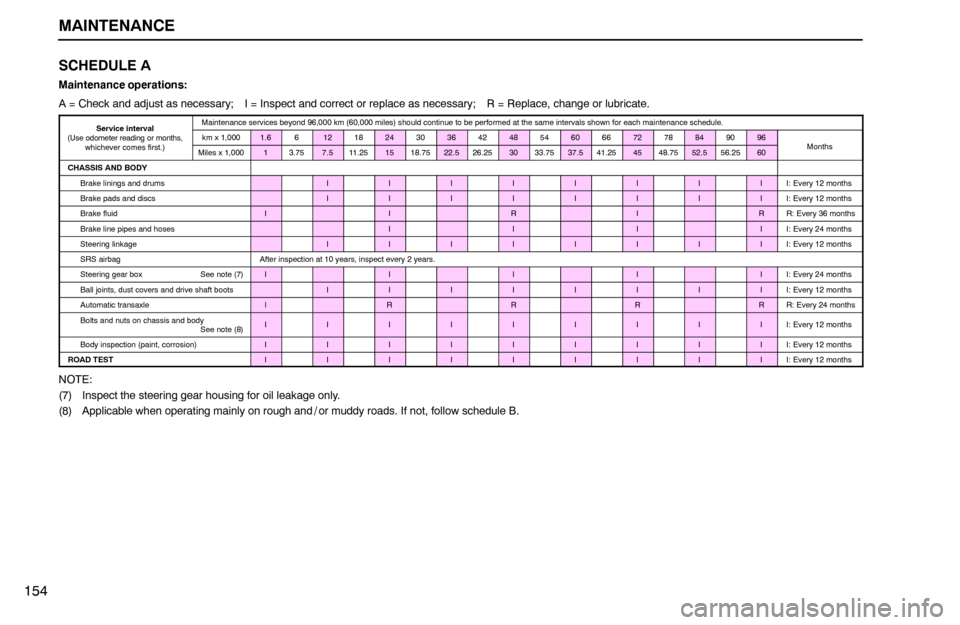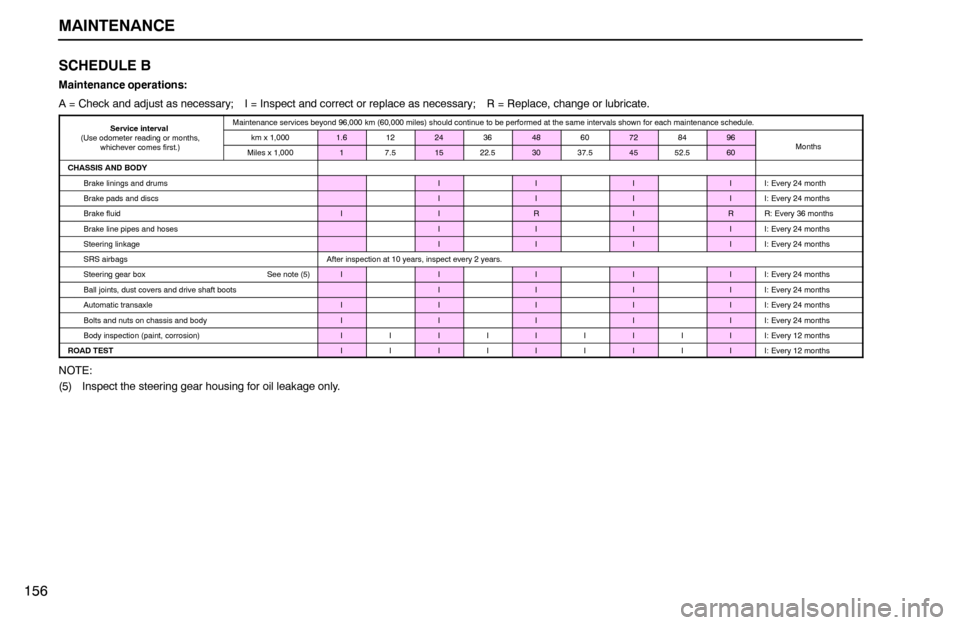Page 4 of 15

MAINTENANCE
148Fluid leaks
Check underneath for leaking fuel, oil, water or other fluid after
the vehicle has been parked for a while. If you smell fuel fumes
or notice any leak, have the cause found and corrected
immediately.
Doors and engine hood
Check that all doors, including trunk lid, operate smoothly and
all latches lock securely. Make sure the engine hood
secondary latch secures the hood when the primary latch is
released.
Vehicle interior
Items listed below should be checked regularly, e.g. while
performing periodic services, cleaning the vehicle, etc.
Lights
Make sure the headlight, stop lights, tail lights, turn signal
lights, and other lights are working. Check headlight aim.
Service reminder indicators and warning buzzers
Check that all service reminder indicators and warning
buzzers function properly.
Steering wheel
Check that it has the specified freeplay. Be alert for changes
in steering condition, such as hard steering, excessive
freeplay or strange noise.
Seats
Check that all front seat controls such as seat adjusters,
seatback recliner, etc. operate smoothly and that all latches
lock securely in any position. Check that the head restraints
move up and down smoothly and that the locks hold securely
in any latched position.
Seat belts
Check that the seat belt system such as buckles, retractors
and anchors operate properly and smoothly. Make sure the
belt webbing is not cut, frayed, worn or damaged.
Page 6 of 15

MAINTENANCE
150Power steering fluid level
Check the level through the reservoir. The level should be in
the “HOT” or “COLD” range depending on the fluid
temperature. See page 181 for additional information.
Exhaust system
Look for cracks, holes and loose supports. If you notice any
change in the sound of the exhaust or smell exhaust fumes,
have the cause located and corrected immediately. (See
engine exhaust cautions in Section 3−1.)
DOES YOUR VEHICLE NEED
REPAIRING?
Be on the alert for changes in performance and sounds, and
visual tip−offs that indicate service is needed. Some important
clues are:
�Engine missing, stumbling, or pinging
�Appreciable loss of power
�Strange engine noises
�A fluid leak under the vehicle (However, water dripping from
the air conditioning after use is normal.)
�Change in exhaust sound (This may indicate a dangerous
carbon monoxide leak. Drive with the windows open and
have the exhaust system checked immediately.)
�Flat−looking tires, excessive tire squeal when cornering,
uneven tire wear
�Vehicle pulls to one side when driving straight on a level
road
�Strange noises related to suspension movement
�Loss of brake effectiveness, spongy feeling brake pedal,
pedal almost touches floors, vehicle pulls to one side when
braking
�Engine coolant temperature continually higher than normal
Page 10 of 15

MAINTENANCE
154SCHEDULE A
Maintenance operations:
A = Check and adjust as necessary; I = Inspect and correct or replace as necessary; R = Replace, change or lubricate.
Service interval
(Use odometer reading or months,
whichever comes first.)Maintenance services beyond 96,000 km (60,000 miles) should continue to be performed at the same intervals shown for each maintenance schedule.km x 1,0001.66121824303642485460667278849096MonthsMiles x 1,00013.757.511.251518.7522.526.253033.7537.541.254548.7552.556.2560CHASSIS AND BODYBrake linings and drumsIIIIIIIII: Every 12 monthsBrake pads and discsIIIIIIIII: Every 12 monthsBrake fluidIIRIRR: Every 36 monthsBrake line pipes and hosesIIIII: Every 24 monthsSteering linkageIIIIIIIII: Every 12 monthsSRS airbagAfter inspection at 10 years, inspect every 2 years.Steering gear box See note (7)IIIIII: Every 24 monthsBall joints, dust covers and drive shaft bootsIIIIIIIII: Every 12 monthsAutomatic transaxlelRRRRR: Every 24 monthsBolts and nuts on chassis and body
See note (8)IIIIIIIIII: Every 12 months
Body inspection (paint, corrosion)IIIIIIIIII: Every 12 monthsROAD TESTIIIIIIIIII: Every 12 months
NOTE:
(7) Inspect the steering gear housing for oil leakage only.
(8) Applicable when operating mainly on rough and / or muddy roads. If not, follow schedule B.
Page 12 of 15

MAINTENANCE
156SCHEDULE B
Maintenance operations:
A = Check and adjust as necessary; I = Inspect and correct or replace as necessary; R = Replace, change or lubricate.
Service interval
(Use odometer reading or months,
whichever comes first.)Maintenance services beyond 96,000 km (60,000 miles) should continue to be performed at the same intervals shown for each maintenance schedule.km x 1,0001.61224364860728496MonthsMiles x 1,00017.51522.53037.54552.560CHASSIS AND BODYBrake linings and drumsIIIII: Every 24 monthBrake pads and discsIIIII: Every 24 monthsBrake fluidIIRIRR: Every 36 monthsBrake line pipes and hosesIIIII: Every 24 monthsSteering linkageIIIII: Every 24 monthsSRS airbagsAfter inspection at 10 years, inspect every 2 years.Steering gear box See note (5)IIIIII: Every 24 monthsBall joints, dust covers and drive shaft bootsIIIII: Every 24 monthsAutomatic transaxleIIIIII: Every 24 monthsBolts and nuts on chassis and bodyIIIIII: Every 24 monthsBody inspection (paint, corrosion)IIIIIIIIII: Every 12 monthsROAD TESTIIIIIIIIII: Every 12 months
NOTE:
(5) Inspect the steering gear housing for oil leakage only.
Page 14 of 15

MAINTENANCE
158CHASSIS AND BODY
Brake linings and drums
Check for scoring, burning, broken parts, and excessive wear.
A qualified technician should perform this operation.
Brake pads and discs
Check the pads for excessive wear and discs for runout and
wear, and leaking fluid. A qualified technician should perform
this operation.
Brake fluid
Check for correct levels of the brake fluid. If the level is low, add
FMVSS No. 116 DOT 3 or SAE J1703 brake fluid to the brake
reservoir. Change the brake fluid as scheduled. A qualified
technician should perform these operations.
Brake line pipes and hoses
Visually check for proper installation. Check for chafing,
cracks, deterioration, and any evidence of leaking. Replace
any deteriorated or damaged parts immediately. A qualified
technician should perform these operations.
Steering linkage
With the vehicle stopped, check for excessive freeplay in the
steering wheel. Check the linkage for bends or damage. Check
the dust boots for deterioration, cracks, or damage. Replace
any damaged parts.
SRS airbags
This should be periodically inspected by a qualified technician.
For details, see the maintenance schedule.Steering gear box
Inspect the steering gear box for signs of leakage. If you
discover any leakage, have it repaired by a qualified technician
immediately.
Drive shaft boots
Inspect the drive shaft boots for clamp looseness, grease
leakage or damage. Replace any deteriorated or damaged
parts immediately. A qualified technician should perform these
operations.
Ball joints and dust covers
Check the suspension and steering linkage ball joints for
looseness or damage. Check all dust covers for deterioration
or damage. A qualified technician should perform these
operations.
Automatic transaxle
Inspect each component for signs of leakage. If you discover
any leakage, have it repaired by a qualified technician
immediately. Under severe driving conditions, change the fluid
and oil when scheduled.
Bolts and nuts on chassis and body
Where necessary, retighten to specified torque.
Body inspection (paint, corrosion)
Visually check for corrosion, scratches and other damage.
Check body outer panels, underneath the vehicle, inner panels
of the hood and doors, etc. Apply touch−up paint to any chips
or scratches, or have them repaired by a qualified technician.
Page 15 of 15
MAINTENANCE
159 ROAD TEST
While driving the vehicle, check the proper operation of engine,
transaxle, brakes and steering, and check for abnormal noise
or vibration from any part of the vehicle.